Museums in Rome: A Gem on Via del Corso
Galleria Doria Pamphilj – an Art Historian's Paradise!
Rome is often described as a living museum; on every corner, there seem to be some museum, church, palazzo, villa, ancient ruins, or even a simple series of apartments, with a long and rich history. You can’t throw a stone without hitting something historical, and frankly, that makes it my kind of city. I love looking at buildings that let you identify their layers, the visual passage of time, and the way it all mish-mashes proudly together. One particular museum that I’d never heard of before going to Rome is the small and unassuming Galleria Doria Pamphilj.
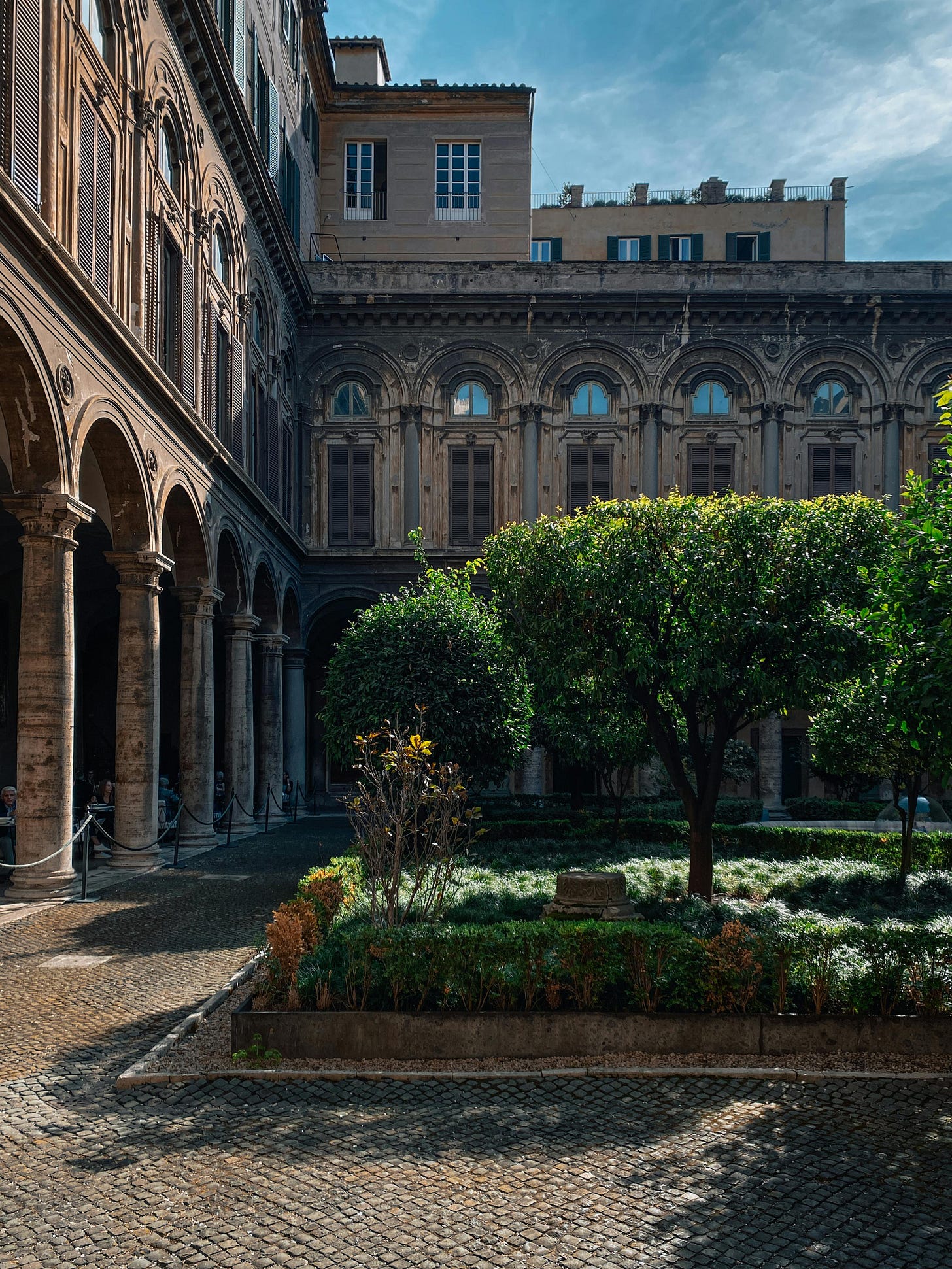
Some Background
Located on the bustling Via del Corso, Galleria Doria Pamphilj sits beside the church of Santa Maria in Via Lata. While a portion of this grand palazzo has been converted into a museum, it is still privately owned by the eponymous Doria Pamphilj family who still reside in the palazzo’s private apartments.
The Doria Pamphilj is one of the great families of Roman nobility, whose lineage stretches back to the 11th century. This dynasty is made up of different Italian noble families: The Doria, Landi, Pamphilj, and Aldobrandini, united through marriage under the simplified name of Doria Pamphilj.
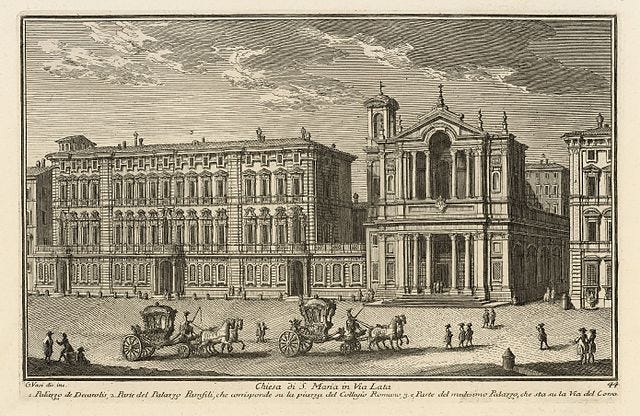
The Palazzo itself is the result of 500 years of additions, renovations, and expansions. A majority of these projects were done under Prince Camillo Pamphilj after he married Olimpia Aldobrandini – the widow of Paolo Borghese, another prominent Roman family, and the namesake of another fantastic museum in Rome, Galleria Villa Borghese. The couple settled into the palazzo on Via del Corso in 1648. This marriage, not only united the two “great fortunes of the period,” but laid the foundation for the Doria Pamphilj art collection (BIOGRAPHIES Rome, Doria Pamphilj, “Olimpia Aldobrandini”).
Honestly, when I made plans to meet up with friends, and fellow art historians, at the gallery, I got lost. The front of the palazzo doesn’t look like a palazzo, it looks like a building in need of a power wash. Respectfully.
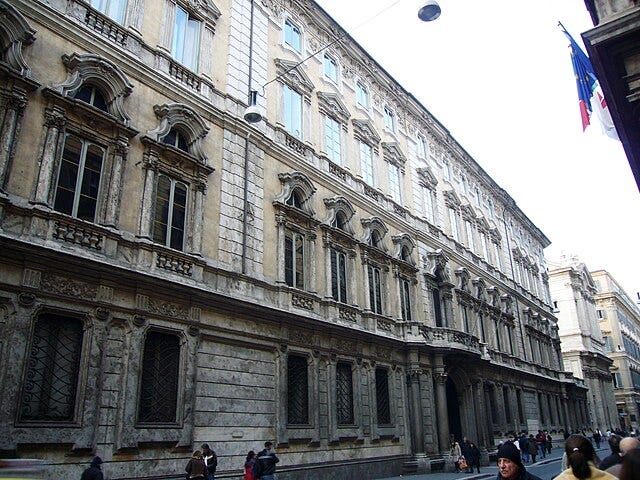
However, once you enter the arched doorway, you will feel like you’ve stepped into another world. A gilded age of splendor, opulence, and power, with a tinge of corruption and back-handed plots. You’ll see what I mean when we meet the notorious matriarch of the family, Donna Olimpia Maidalchini Pamphilj.
The Gallery
The exhibition spaces open to the public are laid out in a series of four wings surrounding a picturesque courtyard — which you see when you first walk in from Via del Corso. The collection itself includes paintings and decor from Pope Innocent X’s Palazzo Pamphilj (in Piazza Navona), medieval and Byzantine art, Dutch and Flemish masterpieces, classical sculpture, and incredible ceiling frescoes. My favorite part? A mini-Versailles in the form of a gilded hall of mirrors!
You have the option to take an audio tour, as we didn’t know much about the collection our little group accepted, thinking we’d be given a small pair of headphones. Instead, we were given long, bulky devices that looked like phones without the landline. Holding it up to our ears, it looked like we were on individual conference calls. It’s a bit uncomfortable, but the information is completely worth it.
It’s also narrated by Prince Jonathan Doria Pamphilj himself, who still lives in the palace with his family. This meant we got many anecdotes and tidbits along with the formal history lesson.
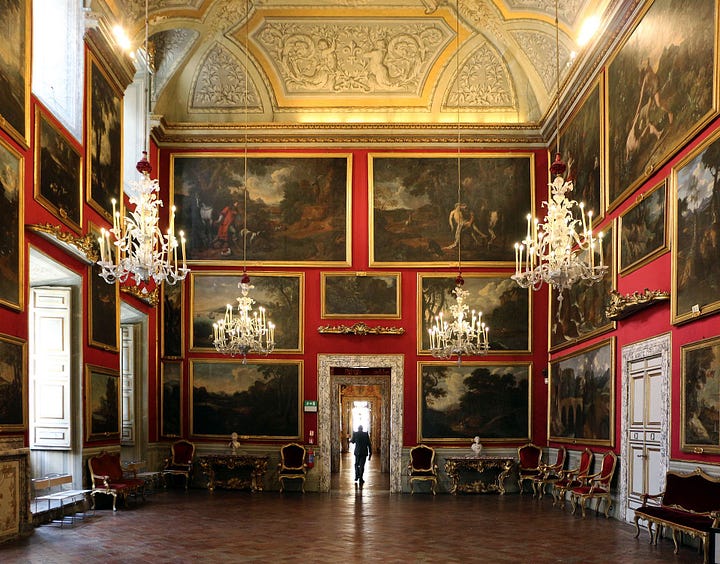
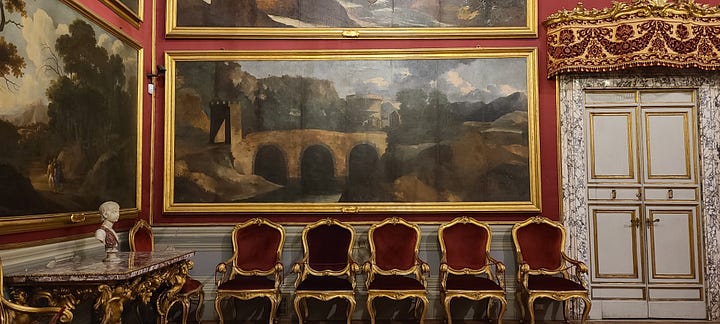
The first was a brilliant red room dedicated to the artist Gaspard Dughet, known also as “Pussino.” Stacked atop each other, Salon style as art historians call it, the paintings are beautiful examples of 17th and 18th-century art in gilded frames. Roman landscapes and biblical scenes all designed to make an enormous impact.
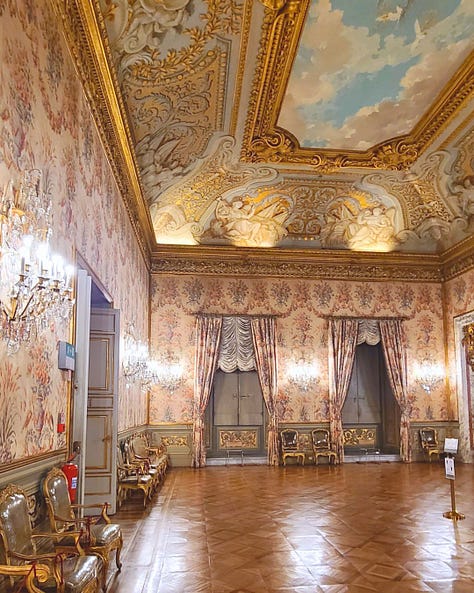
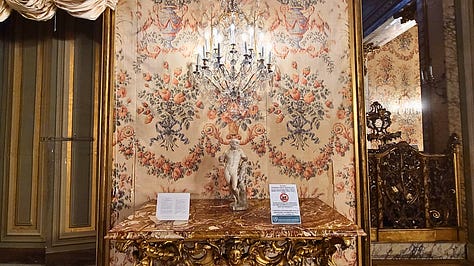

As we went on, we entered the sweetest room, covered in delicate floral pink wallpaper. The Ballroom or “Music Room” is a combination of two rooms that were eventually combined, and saw many extravagant affairs in its day! In the corner sits a delicate orchestra pit with antique instruments, crystal sconces refitted for the advent of electricity line the walls, and a ceiling fresco of doves flying looking down on the entire show.
Gilded statues of cupids stand in the corners, as we listen to our guides. Classical music was played on the audio guide, so we took the opportunity to dance since the gallery was empty!

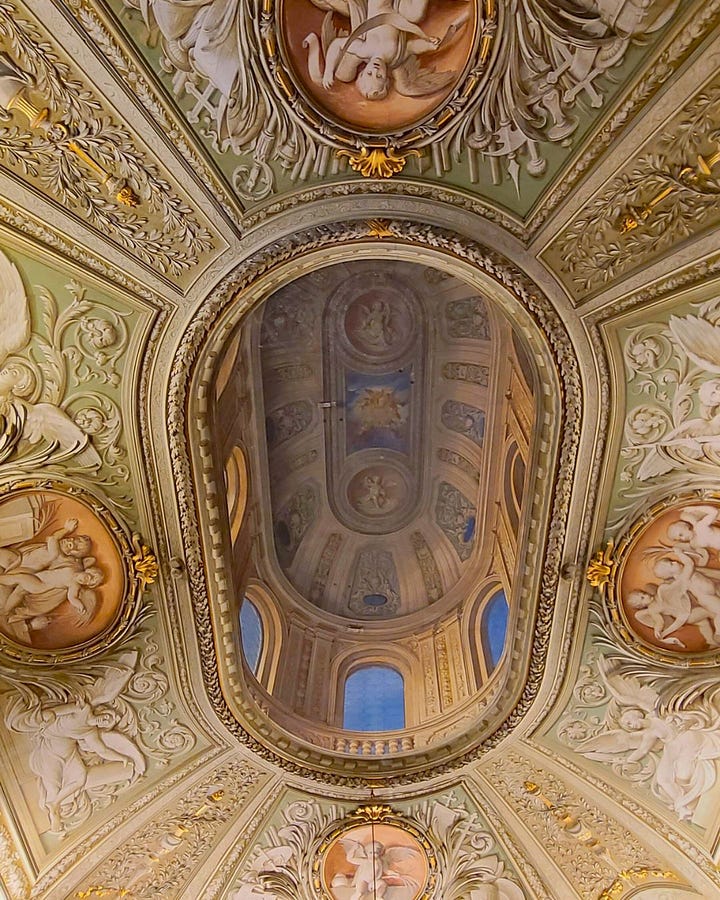
Next, we came upon the palazzo’s chapel. It was common for these grand estates to include private places of worship for the family. This beautiful chapel was originally designed by Carlo Fontana between 1689 and 1691, and features an incredible trompe l’oeil ceiling fresco, creating the illusion of a dome, a gilt-bronze hanging lamp designed by Bernini (one of my favorite artists), and even the perfectly preserved remains of the family saint, S. Theodora.
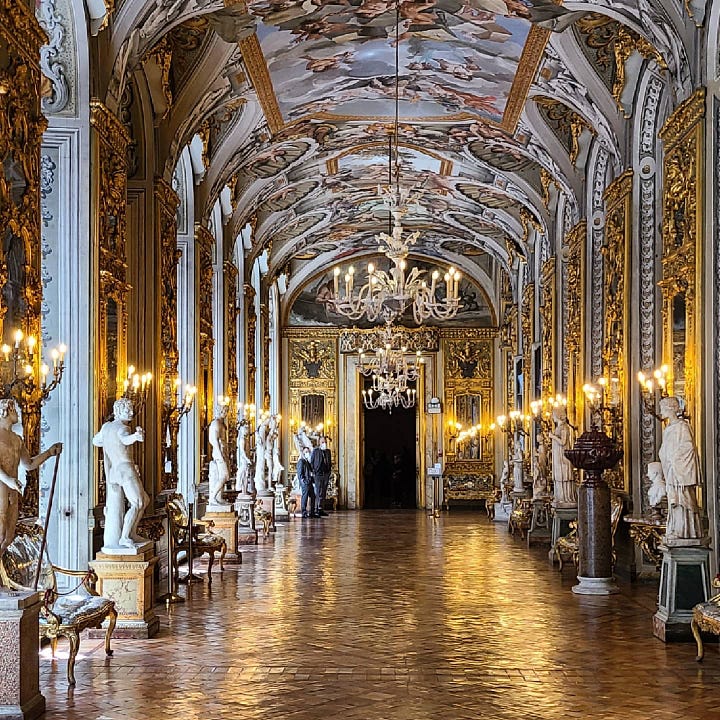
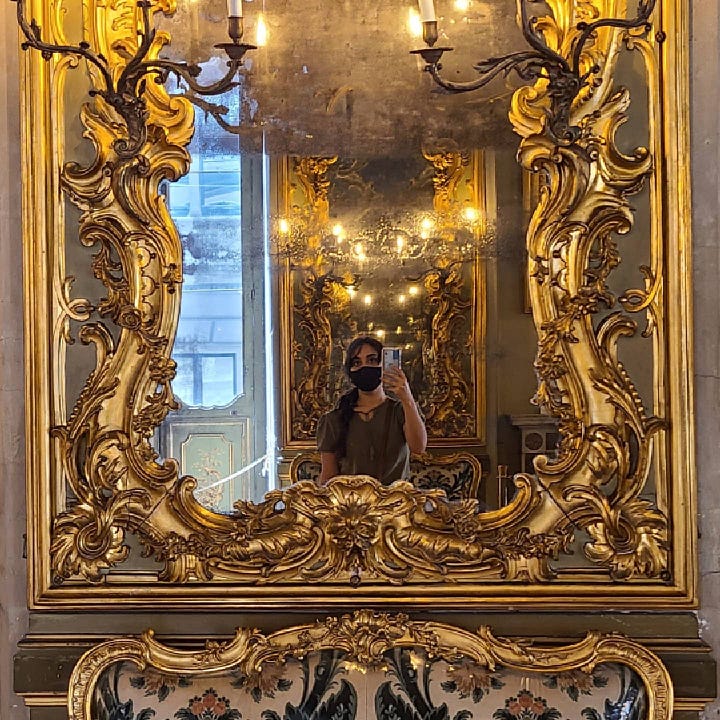
The nicest surprise, however, was the Hall of Mirrors! Jaws dropped when we turned the corner onto this mini-Versailles. Designed by Gabriele Valvassori in the 18th century, this opulent hall alternates gilded Venetian mirrors with ancient sculptures. This section deserves a long, slow walk to take it all in, so don’t be afraid to slow down. The frescoes on the vaulted ceiling depict the Labours of Hercules, painted by the Bolognese artist Aureliano Milani, and also deserve your attention.
If you keep walking along this glittering hallway you’ll soon come to two rooms overlooking Via del Corso. The second of these small 16th-century rooms contains not one, but three Caravaggio’s: the Penitent Magdalene, The Rest during the Flight into Egypt, and St. John the Baptist.
Nothing, however, could have prepared me for the story of one of the most notorious members of the Doria Pamphilj family: Donna Olimpia Maidalchini Pamphilj. First, her bust made me stop in my tracks. She looked imposing, powerful, and a little scary with her wide, flowing hood. The audio tour then began to tell us all about this woman known today as “the Mistress of the Vatican.” A wealthy noblewoman from Viterbo, she defied her father’s wishes to join a convent (her father did not want to pay the hefty dowry sum) and married the rich Paolo Nini. Shortly after his death, she married Pamphilio Pamphilj in 1612 who died later in 1639.
Ambitious, intelligent, powerful, and strong-willed, she was an astute businesswoman and amassed most of the family’s riches through advantageous matchmaking. She even promoted her bother-in-law, Monsignor Gianbattista Pamphilj, up the Vatican ladder and straight into the Papal seat in 1644, becoming Pope Innocent X. Not everyone was thrilled and one Cardinal Alessandro Bichi even declared, “Gentlemen, we have just elected a female pope” (Sotheby’s, “Mistress of the Vatican,” 2019).
Olimpia sponsored artists, musicians, and sculptors, and was responsible for arranging Gian Lorenzo Bernini’s creation of the Four Rivers Fountain in Rome’s Piazza Navona. On September 26, 1657, Donna Olimpia died alone due to the plague. Between the rumors that she was thought to be the Pope’s mistress, and her (possibly) having robbed the entire Vatican gold reserve in the Treasury in Castel Sant’Angelo, she was better than a Dan Brown novel. Art history has the juiciest stories. This post has only scratched the surface of this wonderful gem on Rome’s Via del Corso, it’s an art lovers paradise that is guaranteed to be the highlight of anyone’s visit to Rome. Go for the art, stay for the historical gossip.




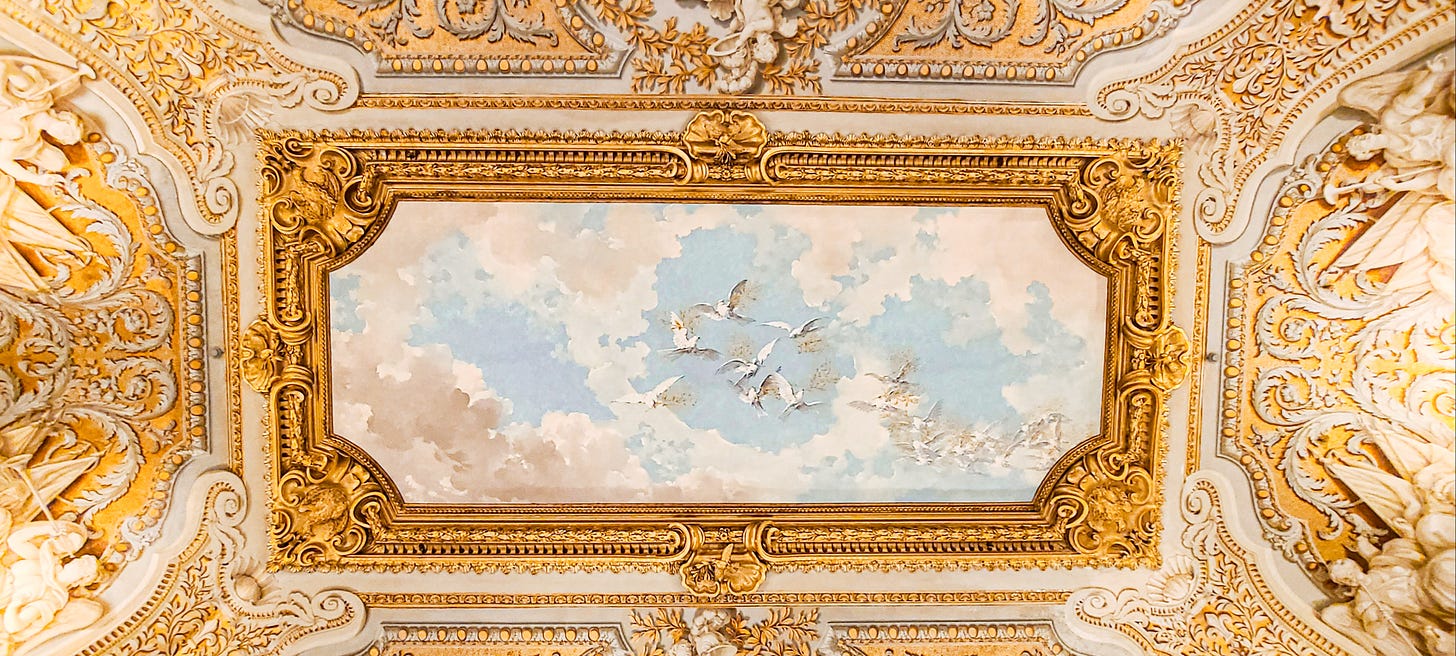


Beautiful reading !!! Love it !! Can’t wait to visit the place !!!
Love it....as always. Keep going...🤩 me encanta viajar por Italia con tu blog.